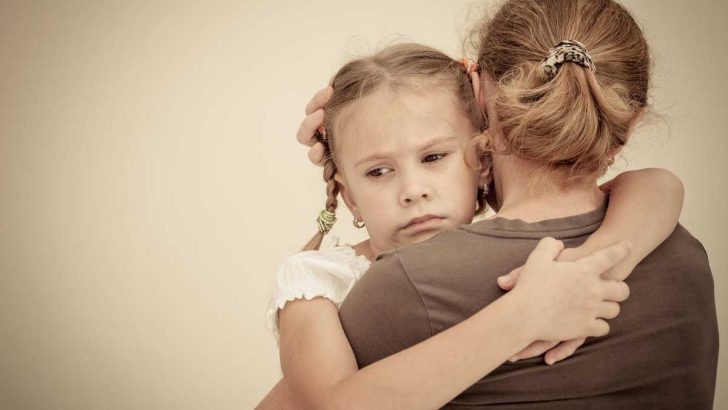I was the first person to abuse and harass my daughter.
Of course, I didn’t intentionally hurt my daughter.
In fact, when she was little, I didn’t think I was behaving like a bully.
Now, looking back, I realize that I wasn’t offering her the support she needed.
If she didn’t do what I wanted her to do, I’d threaten her, tell her I was going to take away her favorite toys.
If she made a mistake, I withdrew my affection to show her that I had control and power.
Moreover, if she wasn’t nice to her brother, I would isolate her and not let her join us until I was ready.
When she misbehaved or tried to resist my orders, I scolded her and shamed her.
On the other hand, when she was kind and calm, I showered her with love, complimented her and offered her the security she was looking for.
Sometimes, when I needed her to do something, I bribed her with a reward.
So she felt good during those moments, even if she was confused the rest of the time.
To tell the truth, just as I was my daughter’s first bully, she became her sister’s bully.
Eventually, I realized that punishments and rewards are detrimental.
Unconditional love, on the other hand, is the only valid approach to parenting.
How does a mother become her children’s tyrant?

It’s unfortunate when a parent becomes a tyrant to their children, because a parent’s role is ideally to nurture and support their child’s well-being.
Various factors can contribute to a mother becoming a bully.
So it’s important to analyze these reasons with sensitivity and understanding in order to understand the mom’s background.
1. Mom has unresolved personal problems

Sometimes a mom may have unresolved personal issues in her own past, such as trauma, low self-esteem or unresolved anger.
These problems manifest themselves later in abusive or intimidating behavior toward her children, because she hasn’t learned to manage her emotions in a healthy way.
2. Stress and frustration are damaging emotions

Parenting can be stressful, and if a mother experiences a lot of stress or frustration, she may unintentionally lash out at her children.
This leads to bullying behavior where the mother becomes excessively critical, harsh, even physically violent towards her children.
3. Lack of appropriate parenting skills or knowledge

Parenting doesn’t come with a manual, and some mothers may not have received adequate guidance or support to develop healthy parenting skills.
Without the necessary tools, they may resort to bullying to exert control or discipline, without realizing the negative impact this can have on their children.
4. The influence of external factors is paramount

A mother’s behavior can also be influenced by external factors, such as her own upbringing, social pressures or unhealthy relationships.
If a mother has grown up in a violent environment or is surrounded by negative influences, this contributes to her becoming a bully to her children.
What kind of parental behavior resembles bullying?

A mom can become her child’s bully if she doesn’t respect his limits or needs.
Verbal abuse is the first level of parental harassment.
It involves name-calling, insults, belittling or using derogatory language towards the child.
It may involve constant criticism, mockery or belittling comments that undermine the child’s self-esteem.
Then there’s physical violence!
Any form of aggression towards a child, such as hitting, slapping, punching, pushing or any other physical act intended to harm or inspire fear.
Emotional manipulation is the most common form of harassment.
It involves manipulative tactics designed to control or intimidate the child.
This may involve guilt-tripping, gaslighting, threatening or using emotional blackmail to get the child to comply with the parent’s demands.
Moreover, exercising unreasonable control over the child’s life, depriving him or her of autonomy and independence, is also a form of parental tyranny.
This can take the form of micromanaging a child’s activities, intruding on his privacy or excessively controlling his every move.
Neglecting a child’s emotional, physical or psychological needs can also be considered a form of harassment: ignoring the child’s feelings, dismissing his or her concerns or denying him or her the care and help he or she needs.
In the digital age, parents can engage in cyberbullying by using technology to harass, humiliate or intimidate their child.
This includes sending threatening messages, sharing embarrassing or private information online, or using social media to shame the child.
Finally, deliberately isolating children from social interactions or preventing them from forming healthy relationships with their peers is also parental harassment.
This may involve limiting social activities, isolating the child from family events or forbidding participation in extracurricular activities.
How can you repair the harm done to your child?

To repair the harm done to your own child, you need to make a sincere commitment to change.
Reflect on yourself and take concrete steps to rebuild trust and establish a healthier relationship.
Don’t think that change or family happiness will happen overnight.
You’ll need patience and perseverance.
When you’re ready to do some hard work on yourself, here are the steps you need to take:
- Acknowledge and admit the hurtful behaviors you have engaged in toward your child.
Take full responsibility for your actions, without making excuses or deflecting blame.
- Offer your child a sincere apology
Show remorse for the pain you have caused.
Specify the actions for which you apologize and acknowledge the impact they have had on your child.
Make sure your apology is sincere, without expecting immediate forgiveness.
- Create a safe space for your child to express his emotions and concerns.
Listen carefully and validate his feelings without being defensive or dismissive.
Let them know that their feelings are valid and important.
- Consider hiring a professional to guide you and your child through the healing process.
A professional can facilitate open communication, provide support and suggest strategies for rebuilding the relationship.
- Reflect on the behaviors that led to the injury and commit to making positive changes
Set clear limits and communicate them to your child, ensuring that his or her needs, well-being and personal space are respected.
- Show your child through your actions that you are determined to change.
Show constant love, respect and support.
Be patient and understanding, and allow your child to see the transformation that takes place over time.
- Learn and implement healthy communication techniques
Encourage open dialogue, active listening and empathy.
Create an environment in which your child feels comfortable expressing himself without fear of being judged or punished.
- Be reliable, keep your promises and show that you can be trusted.
Avoid repeating hurtful behavior or resorting to old patterns.
- Create a positive, stimulating environment for your child
Encourage interests, celebrate successes and provide emotional support.
Foster a sense of security, love and belonging within the family.
Hi all, I am Sidney, an accountant, a hobbyist photographer, and a mother to two sweet girls who are my motivation. I love sharing the tips and tricks I gained all these years I’ve been a mother. I hope it will help you!

